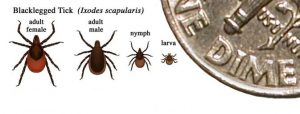Continuing with the topic from my previous post, I’m sharing more of the facts I’ve learned by writing fiction, and in particular, researching the Aimee Machado Mysteries, featuring a health sciences librarian.
Librarians are trained researchers. If they’re curious, they look things up. Here are facts I came across while my protagonist searched for the solution to the mystery in CHECKED OUT, the second book in the Aimee Machado Mystery series.
QUESTION ONE:
How many people in the U.S. get Lyme disease within a given year?
FACT: The Center for Disease Control estimates 300,000 cases per year.
In the U.S., Lyme disease is spread through the bite of a tiny blacklegged tick.

Most infections occur in three principal areas:
- Northeast and mid-Atlantic, from northeastern Virginia to Maine
- North central states, mostly in Wisconsin and Minnesota
- West Coast, particularly northern California
The areas listed are based on where people live, not necessarily where they became infected. Cases diagnosed and reported from an area where Lyme disease is not expected are almost always travel-related.
A national survey found that nearly 20 percent of people surveyed where Lyme disease is common were unaware that it was a risk. Half the people interviewed in another study did nothing to protect themselves against tick bites during warm weather.
For more complete information on Lyme disease, visit the Centers for Disease Control and Prevention website. https://www.cdc.gov/lyme/index.html
Image courtesy of Centers for Disease Control and Prevention
BOOK TWO – QUESTION TWO:
How much can a champion cutting horse earn in one year?
FACT: A three-year-old cutting horse taking first place at a National Cutting Horse Association (NCHA) event can win as much as $250,000. By competing in several events during a given year, the same horse can earn as much as a million dollars. Worldwide, total cutting horse event winnings in one year average more that 30 million dollars.
For more complete information on cutting horses, visit http://www.nchacutting.com/
To contact a cutting horse trainer, call 530-945-6079, or visit https://www.facebook.com/RandyBrooksCuttingHorses
Cutting horse photo courtesy of Randy Brooks.
Visit www.sharonstgeorge.com again soon for facts I learned by writing Book Three of the Aimee Machado Mysteries.
Books in the hospital-based Aimee Machado Mysteries, published by Camel Press, are available for purchase from Amazon, Barnes and Noble, and from your local bookstore in trade paperback and as ebooks.



